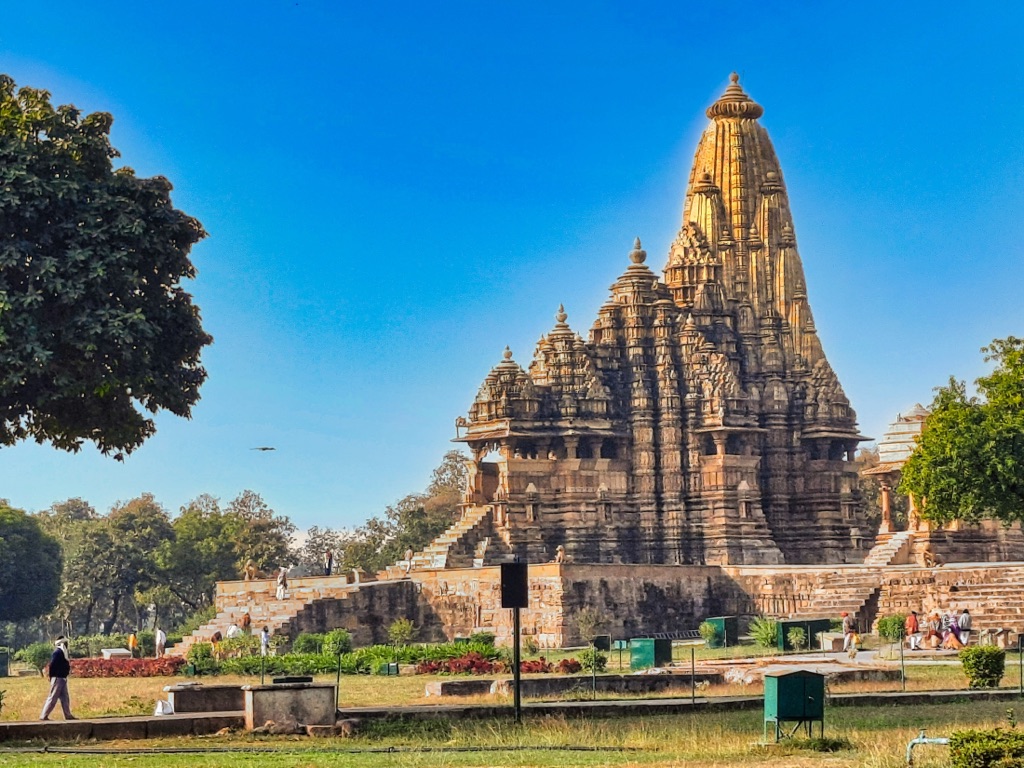The Kandariya Mahadeva Temple stands as a testament to the architectural and spiritual zenith of the Chandela dynasty. Located in Khajuraho, Madhya Pradesh, India, this temple is the largest and most ornate Hindu temple in the medieval temple group found at the site. Dedicated to Lord Shiva, it represents the pinnacle of North Indian temple architecture with its intricate carvings, soaring shikhara, and complex symbolism. The temple, dating back to the 11th century, is a UNESCO World Heritage Site and continues to draw admirers from around the world for its artistic magnificence and historical significance.
Get your dose of History via Email
Historical Background of Kandariya Mahadeva Temple
The Kandariya Mahadeva Temple was discovered by the British in the 19th century. T.S. Burt, a British engineer, stumbled upon the ruins in 1838. The Chandela rulers, who rose to power in Central India between the 10th and 13th centuries, built this temple. It was during the reign of King Vidyadhara, from 1017 to 1029 AD, that the temple construction likely took place. The Chandelas were patrons of art and architecture, and under their rule, a total of 85 temples were constructed, of which only 22 have survived.
After the decline of the Chandela dynasty, the temple was abandoned and overgrown by dense forest, which helped preserve it from destruction. It was not inhabited or used for significant historical events in the following centuries. However, its rediscovery brought it back to prominence, allowing historians and archaeologists to delve into its past.
The temple’s construction is attributed to the Chandela dynasty, but the specific architects or craftsmen remain unknown. The Chandelas were known to commission temples to demonstrate their devotion and to establish their kingdom’s prosperity and power. The Kandariya Mahadeva Temple is the most grandiose manifestation of their architectural legacy.
While the temple did not witness historical events after the Chandela period, its sculptures and architecture reflect significant aspects of medieval Hindu society. The temple’s artwork presents a vivid portrayal of the lifestyle, attire, and social practices of the time. It also serves as a spiritual beacon, with its sanctum believed to house a Shiva linga, symbolizing the deity’s energy and potential.
The temple has not been the scene of any historically important events in recent times. However, it continues to be an important site for scholars and devotees alike. Its annual festivals attract pilgrims and tourists, keeping the temple’s cultural significance alive.
About Kandariya Mahadeva Temple
The Kandariya Mahadeva Temple is a masterpiece of medieval temple architecture. It is built in the Nagara style, characterized by a beehive-shaped tower, known as a shikhara, which rises above the sanctum. The temple complex is laid out in a series of steep rises, culminating in the shikhara that stands approximately 31 meters high.
The temple’s construction involved intricately carved sandstone, assembled without the use of mortar. The stones were put together using a precise interlocking system, which has withstood the test of time. The platform, or jagati, upon which the temple stands, is itself a work of art, adorned with a multitude of sculptures depicting various deities, apsaras, and mythical creatures.
Architectural highlights include the main hall (mandapa), the vestibule (antarala), and the sanctum sanctorum (garbhagriha). The walls of the temple are profusely decorated with carvings that depict scenes from daily life, mythological stories, and a variety of erotic sculptures. These sculptures are not merely decorative but also hold symbolic meaning, representing the tantric philosophy that permeates the temple’s design.
The temple’s layout is symbolic, representing the Hindu cosmology with the garbhagriha at the center, symbolizing the divine essence. The ascending shikhara represents the mountainous home of the gods and the rise to spiritual heights. The temple’s design aligns with the principles of Vastu Shastra, an ancient Indian science of architecture and space.
The Kandariya Mahadeva Temple’s construction techniques and artistic embellishments are a testament to the advanced skills of the Chandela craftsmen. The temple’s beauty lies not only in its grand scale but also in the minute details of its carvings, which continue to awe and inspire visitors to this day.
Theories and Interpretations
Several theories and interpretations surround the Kandariya Mahadeva Temple, particularly regarding its use and the symbolism of its sculptures. Some scholars suggest that the temple served not only as a place of worship but also as a representation of royal authority and divine rule. The erotic sculptures, which have garnered much attention, are often interpreted as tantric symbols reflecting the integration of the physical and the spiritual.
The temple’s purpose as a religious site is clear, but the presence of secular scenes suggests a broader cultural significance. These depictions may have served as a form of education on dharma, artha, kama, and moksha—the four goals of Hindu life. The temple thus becomes a holistic representation of the human experience, as seen through the lens of Hindu philosophy.
There are mysteries surrounding the temple, particularly the exact reasons for the inclusion of erotic art. Some theories propose that these carvings were meant to ward off evil spirits, while others believe they were intended to promote fertility and prosperity. The true intent may be a combination of these and other cultural factors that influenced the Chandela rulers.
Historians and archaeologists have matched the temple’s architectural features and iconography with historical records from the period. This has helped establish the temple’s construction period and the dynasty responsible for its creation. Dating of the temple has been carried out through architectural style analysis and corroborating historical texts.
The Kandariya Mahadeva Temple continues to be a subject of study, with new interpretations emerging as scholars delve deeper into its history and symbolism. The temple’s complexity ensures that it remains a source of fascination and academic inquiry for years to come.
At a glance
Country: India
Civilization: Chandela Dynasty
Age: Approximately 1029 AD
Conclusion and Sources
Reputable sources used in creating this article:
- Wikipedia: https://en.wikipedia.org/wiki/Kandariya_Mahadeva_Temple
- World History Encyclopedia: https://www.worldhistory.org/Khajuraho/
- UNESCO World Heritage Centre: https://whc.unesco.org/en/list/240

